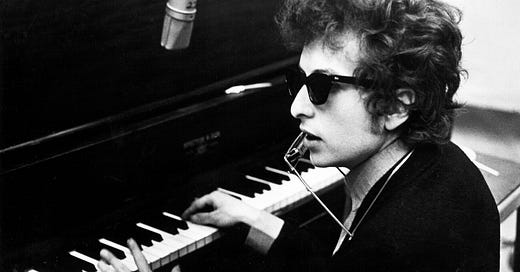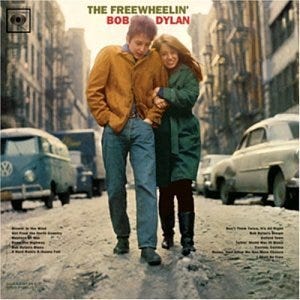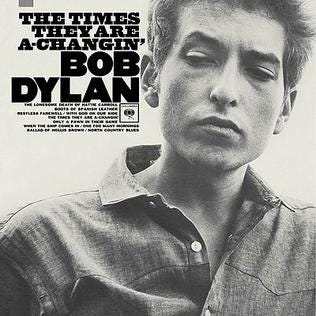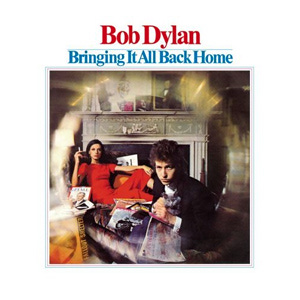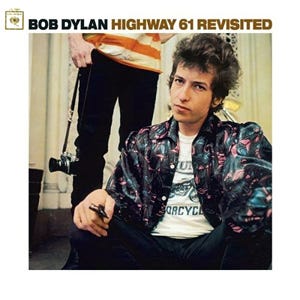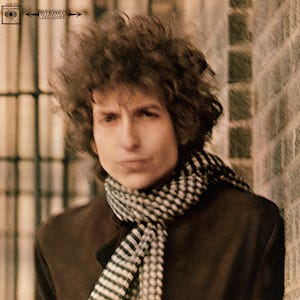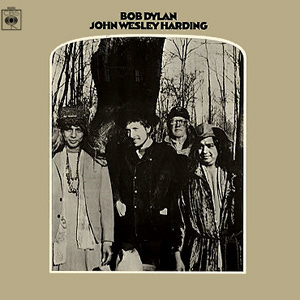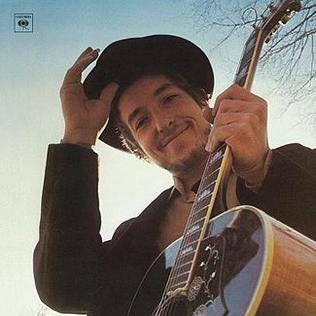I did not make any official resolutions for the new year, but one of my loose goals for 2025 is to listen to every single Bob Dylan studio album. There are 40 of them as of today, and I have listened to all of them up to 1992 so far.
There is so much history to explore within each era of his career, so I wanted to share some feelings on the general direction of each of his nine albums released in the 1960s, as well as my favorite songs from each one (and a playlist of them at the end).
1. ‘Bob Dylan’ (1962)
Columbia Records was not ready for a full album of original songs from a complete unknown, so Dylan’s first studio record is largely comprised of traditional folk tunes, albeit with new arrangements. Only two of the songs on this record are completely new material, “Talkin’ New York” and “Song to Woody,” a tribute to Dylan’s idol, Woody Guthrie.
This album doesn’t offer much of the poetic, prophetic songwriting Dylan would quickly be renowned for, but it is a decent collection of American folk standards delivered with a unique, new voice.
Favorite Tracks:
“Song to Woody”
2. ‘The Freewheelin’ Bob Dylan’ (1963)
The opening track, “Blowin’ in the Wind,” is perhaps the greatest shot caller in popular American music history, a song so powerful and in tune with the times in which it was written that Dylan is immediately lauded with the high expectations, adoration, and scholarship that will follow through the rest of his career.
The Freewheelin’ Bob Dylan is not his debut, but it is the true introduction to Dylan’s mastery over the art of American songwriting.
Favorite Tracks:
“Blowin’ in the Wind”
“Girl From the North Country”
“Masters of War”
“A Hard Rain’s a-Gonna Fall”
“Don’t Think Twice, It’s All Right”
3. ‘The Times They Are a-Changin’ (1964)
Dylan came fully formed with his second LP, and he followed it up in 1964 with more political and socially minded folk songs. At the time, the Civil Rights movement was a foundation that much folk music orbited around, and Dylan’s anthemic title track from this record is a great example of this protest music cementing itself to the era and context in which it was written.
The Times They Are a-Changin’ is more of the same if you like his second record, and I’d consider it the last album before his particular style of writing becomes crystalized.
Favorite Tracks:
“The Times They Are a-Changin’”
“Ballad of Hollis Brown”
“One Too Many Mornings”
“The Lonesome Death of Hattie Carroll”
4. ‘Another Side of Bob Dylan’ (1964)
This album marks the first of Dylan’s many, controversial departures from the status quo of folk music. The musical stylings are familiar, but Another Side of Bob Dylan received some criticism at the time for its songwriting. Dylan moved away from protest music into writing songs with far more cryptic, literary, or humorous overtones.
Another Side of Bob Dylan speaks to me as the introduction of the streams-of-consciousness style of writing that will define the most important songs of his career. That style will develop rapidly over his next three albums, along with a stark change of instrumentation, leaving Another Side of Bob Dylan as an oft forgotten early record that exists in a transitional period for Dylan’s career.
Favorite Songs:
“All I Really Want to Do”
“Chimes of Freedom”
“It Ain’t Me Babe”
5. ‘Bringing It All Back Home’ (1965)
Starting with this album, Dylan released three electric opuses over the course of a year and a half. Bringing It All Back Home is, in essence, the catalyst for the entire conception of folk rock. The front half is an electrifying change of pace, and the back half is a collection of acoustic ballads that are all among some of Dylan’s most impassioned and thoughtful songs ever composed.
This is one of the first Dylan albums I ever listened to, and it has steadily remained a personal favorite over his 40-album discography. If you love his early acoustic work, the back half of this track list is some of his absolute best writing. If you love his electric era, this is where it all started, and it started with a bang.
Favorite Tracks:
“Subterranean Homesick Blues”
“Maggie’s Farm”
“Love Minus Zero/No Limit”
“Outlaw Blues”
“Mr. Tambourine Man”
“It’s Alright, Ma (I’m Only Bleeding)”
“It’s All Over Now, Baby Blue”
6. ‘Highway 61 Revisited’ (1965)
The mid-point of Dylan’s electric trilogy is the one I return to the least often, but “Like a Rolling Stone” is an undeniable masterwork that cannot be ignored when looking at a tapestry of his greatest songs. I al
Favorite Tracks:
“Like a Rolling Stone”
“Tombstone Blues”
“It Takes a Lot to Laugh, It Takes a Train to Cry
“Ballad of a Thin Man”
“Highway 61 Revisited”
7. ‘Blonde on Blonde’ (1966)
Blonde on Blonde marked the end of what I’d call the most impressive three-album run of any contemporary, popular, American artist.
Not only is it one of Dylan’s absolute best records, but it is one of the greatest American musical projects in modern history. When you listen to the Keatsian, poetic prose of “Visions of Johanna,” it is no surprise that Dylan would become the first (and only, as of 2025) musician to receive the Nobel Prize in Literature.
Recorded primarily in Nashville, Blonde on Blonde was one of the first double albums in a popular genre such as folk or rock, an ambitious undertaking that rewards the listener for all 73 minutes. Because of the length, I would not necessarily recommend it as an entry point into Dylan’s discography, but it is one that will grow and grow on you once you familiarize yourself with his work. Blonde on Blonde is the best album on this list, and only potentially rivaled by one other record (Blood on the Tracks) over his career.
Favorite Tracks:
“Visions of Johanna”
“One of Us Must Know”
“I Want You”
“Stuck Inside of Mobile With the Memphis Blues Again”
“Most Likely You Go Your Way, and I’ll Go Mine”
“4th Time Around”
“Sad Eyed Lady of the Lowlands”
8. ‘John Wesley Harding’ (1967)
Dylan returns to acoustic music for a conceptual album rooted in the story of a famous outlaw. It is a return to form that landed well for the fans who derided his going electric, and a solid batch of songs. John Wesley Harding is not as ambitious or memorable as many of the records which came before it in this decade, but it sees Dylan return to a comfortable, familiar musical environment that always goes over well.
One major highlight is the cryptic “All Along the Watchtower,” a song that shot into legendary status after Jimi Hendrix’s iconic cover. Dylan admired Hendrix so much, and so loved his cover, that he borrowed Hendrix’s arrangement and continued to play the song in that style for years.
Favorite Songs:
“John Wesley Harding”
“All Along the Watchtower”
“Dear Landlord”
“I’ll Be Your Baby Tonight”
9. ‘Nashville Skyline’ (1969)
Dylan worked a lot in Nashville, but this record saw him transform into an outright country musician, with twangy instrumental backing and a new, crooning voice that stuck around for a couple albums into the 1970s. Nashville Skyline is short, sweet, and infectious. Dylan’s voice sounds great, and hearing him and Johnny Cash trade lines on a new recording of “Girl From the North Country” is a real treat.
Favorite Tracks:
“Girl From the North Country” (with Johnny Cash)
“To Be Alone With You”
“I Threw It All Away”
“Lay Lady Lay”

